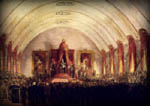Sir SandFord Fleming - The Knight Of Time
The beaver postage stamp

When the postmaster general asked him to create an illustration for the first Canadian postage stamp, Sandford Fleming did not choose the traditional portrait of Queen Victoria. Instead, he suggested the beaver, and this choice helped make the animal a symbol of Canada.
The symbol referred both to the beaver’s role as the foundation of the Canadian economy for many years and to the animal’s industrious habits, which Fleming felt were a Canadian character trait. On April 23, 1851, the “three-penny beaver” went on sale.
Sandford Fleming designed a second stamp, the “six-penny consort”, representing Queen Victoria’s husband (Prince Albert), issued the same year on May 17. He also designed one of Canada’s most famous stamps, the “twelve-penny black”.
As a source of inspiration, Fleming had in his home a portrait of the Queen that he had rescued from a burning building: on April 25, 1849, the Parliament Building in Montreal, which at the time was the Canadian capital, was torched by rioters.
The works of our students:
![]() The first stamp (.pdf - 1,2Mb) |
Transcription
The first stamp (.pdf - 1,2Mb) |
Transcription
Note: For best viewing of this site, you will need this plugin:
![]() Download Adobe reader
Download Adobe reader